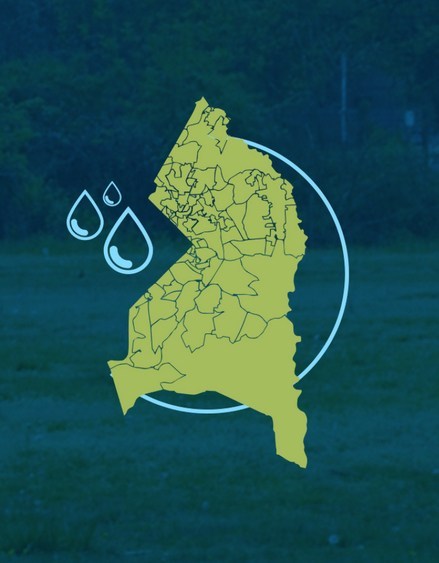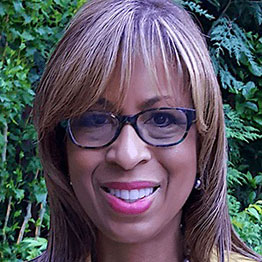CLiGS Instructor Brings EPA Experience to Private Sector in Green Infrastructure
By: Alec Masella
July 2, 2019

Turning sustainability goals into action can be an arduous process, requiring skills in mass communication, civics, economics, and corporate management. Virginia Tech’s Center for Leadership in Global Sustainability Online Master of Natural Resources instructor Dominique Lueckenhoff has made outstanding efforts to prepare students to navigate the complexities of sustainable action. In bringing together her experiences with private-sector business models, academia, government regulatory/non-regulatory programs, and collaborative problem-solving, Lueckenhoff offers her students a broad perspective on how to execute and lead these efforts.
In addition to co-teaching a course on Innovative Water Partnerships, Lueckenhoff has recently taken a leadership position at Hugo Neu Corporation as the Vice President for Corporate Affairs and Sustainability. Her executive management position at this very pro-environment, mission-driven organization gives her both insight and strategic influence regarding the company’s endeavors and investments in community-wide sustainability efforts. Her particular areas of focus include smarter and greener ways, through which to redevelop real estate, grow diverse jobs and economies, and restore the environment, with emphasis on water resources, renewable energy and recycling. Having served as a director and senior advisor for the Environmental Protection Agency (EPA), Lueckenhoff understands the necessity of public sector involvement—the earlier, the better—for the success of these large-scale endeavors.
“There’s a broad universe of different types of public–private partnerships,” in addition to those that also engage academia and non-governmental organizations, Lueckenhoff explains. “The topic of water, for example, has come to light in the age of climate change: increased storm frequency and intensity, impacting vulnerable natural and built infrastructure already weakened and deteriorated. The affiliated costs to communities is now in the multiple trillions of dollars. To take action, we must figure out smarter, more cost-effective ways to evaluate and solve problems in an integrated fashion. We have to be more cooperative and create and leverage innovative partnerships to do more with less, while growing circular economies that do not destroy natural resources, but, if possible, help to regenerate them to support future generations. I want my students to become creative problem solvers, as well as thought leaders, in these types of innovative, real-world partnership approaches.”
Adaptive real-estate reuse at Kearny Point, New Jersey Sustainable real estate redevelopment can play an important role in successful place-based public–private partnerships that create greater value for resilient communities and resources. Hugo Neu’s mission and goals are oriented towards diverse projects, partnerships, and investments that integrate holistic, inclusive sustainable design and practices, supporting more livable communities. Its showcase development, Kearny Point, is an adaptive reuse initiative on 130 acres, driving greater improvements for “people, planet, and profit.” It provides a host of amenities, including plans for a community park that doubles as high-performance green stormwater infrastructure and biodiversity habitat while providing recreation and access to the waterfront.
Kearny Point also provides healthy office spaces for:
- Emerging clean technology
- Women and minority-owned businesses
- Light manufacturing
- Renewable solar and wind energy
- Green and blue infrastructure for sustainable stormwater management, flood mitigation, and improved air quality
Still early in its evolution, Kearny Point has already received multiple innovative economic redevelopment and Smart Growth awards as a unique, next-generation model for resilient redevelopment. For example, the site is located between the Passaic and Hackensack Rivers, and to ensure greater resiliency against storm surge and sea-level rise, it’s being raised by six feet—well above FEMA’s recommendations.
Developing sustainability cooperatives Assisting in the strategic planning and launch of these types of initiatives has given Lueckenhoff an important vantage point for knowing how to plan, finance, and successfully deliver “model” sustainability cooperatives. She explains, “The private sector plays an important role in the health and welfare of our communities. We support and enable growth for small, women, and minority businesses. We are also working with local universities in creating and supporting an emerging environmental technologies incubator and accelerator on site. The fossil fuel driven economy that benefited our lifestyles has also imparted a legacy of problems, so I want everyone to look at and consider reuse of urban and other developed sites as continuous efforts in sustainable development and resource restoration. It’s an important mindset. My experience in both public and private spaces has taught me how to drive holistic solutions, so now I want to teach that.”
Not only will Kearny Point sprout a brand new community, it will also bring a number of jobs, attracting a diverse working class. This inclusivity is essential to green infrastructure, as it makes the idea of sustainability accessible. Additionally, the biomimicry design aspects of the redevelopment not only support the return of a thriving urban ecology—complete with a set of nesting bald eagles—but also provide aesthetically beautiful office space. The offices are equipped with the best of secure internet technologies and WELL healthy building design, incorporating natural lighting as well as first-time public access and panoramic views of a breathtaking waterfront, encouraging visitors and neighbors alike to spend time with and appreciate the space and location.
Creating effective linkages among partners Clearly, projects like Kearny Point do not appear in a void—they require the curation of visionary planning, smart business management and development, financial and technical expertise, project delivery, and government engagement and regulatory compliance, among other matters. During her time at the EPA, Lueckenhoff led national partnering efforts in growing community-based public–private partnerships, driving environmental improvements, and fostering multi-million dollar sustainable development projects that bridged the gap between community needs, private sector capacity, and government funding and regulatory requirements supporting water resources restoration and protection. Her work in this field enables her to share with and instruct students on a wide range of key performance indicators contributing to successful execution and decision making in achieving and adapting sustainable infrastructure as a process of continuous improvement.
“I want my students to understand why there are so many barriers, how to identify them, and the challenges they present in slowing things down,” she says. “But I also want to show them how to address these issues; which they can do, once they better understand them from multiple stakeholder perspectives. Given my extensive experience with these types of partnership models, I am able to challenge my students on how to think about navigating more effectively towards success. There are certain communities that want to use public funding for sustainability initiatives, but funding protocols create obstacles. I teach my students to always think about how the private sector can help with these challenges. This is where creative planning becomes essential to producing these sorts of major projects.”

Prince George’s County, Maryland, leads green-infrastructure development with a CBP3 The Clean Water Partnership, for example, is highly successful collaboration developed by the government of Prince George’s County, Maryland, and the private business Corvias. As the model’s federal champion, Lueckenhoff planned and launched a demonstration pilot through a finance, delivery, and operation and maintenance model to implement large-scale green stormwater infrastructure, in order for the public jurisdiction to meet its stormwater permit compliance while achieving a variety of multiple benefits for the community. Due to its emphasis on community values, Lueckenhoff coined the “Community-Based Public-Private-Partnership” or CBP3, a first-of-its-kind approach. The resultant CBP3 was an award-winning success, receiving national recognition from a variety of notable entities, including the White House.
Every year, Executive Master of Natural Resources (XMNR) students at Virginia Tech’s Center for Leadership in Global Sustainability examine the initiative as a way to learn about multi-stakeholder partnerships and to take a close look at an excellent example of a CBP3 in action. Principles from the project come in to the program’s class session in Arlington, VA, for an informative panel discussion with students and faculty.
Sharing experience, expertise, and vision for the future “I like the accomplishment of solving local environmental problems,” Lueckenhoff explains, “and I want my students to feel that way as well. I’m excited that the term ‘ecosystem’ has found its way into the private sector, because that means people are starting to pick up on how important the environment is. But the only way to solve big issues is to have the means to do so, and that’s what these models do. Sustainability isn’t for a few, it’s for all. It’s about the people, planet, and profit.”
Lueckenhoff’s former students leave with a sense of responsibility to make change, but also with the competencies to do so. Her future students, on the other hand, will gain valuable insight into just how intricate, but rewarding, the idea-to-action process is. Lueckenhoff’s expertise in federal and private sustainability management are a gift to the classroom and will well prepare future sustainability thinkers for both the governmental and corporate worlds ahead.
---

Dominique Luekenhoff has over 25 years of multi-programmatic experience with the U.S. Environmental Protection Agency (EPA), including more than 22 years of supervisory experience in government. In 2013, she received EPA’s James W. Craig Pollution Prevention Leadership Award for efforts related to alternative financing and innovative P3s. In 2015, her work on community-based public-private partnerships included creating the first guide of its type (“Community Based Public-Private Partnerships (CBP3s) and Alternative Market-Based Tools for Integrated Green Stormwater Infrastructure”) to support communities implementing large-scale, next-generation, sustainable stormwater infrastructure. Her success with the G3 partnership, earned her the EPA National Honor Award for Outstanding Leadership in Collaborative Problem-Solving.
Image Credit: Studios Architecture


